Enze Liu
DeepRec: Towards a Deep Dive Into the Item Space with Large Language Model Based Recommendation
May 22, 2025Abstract:Recently, large language models (LLMs) have been introduced into recommender systems (RSs), either to enhance traditional recommendation models (TRMs) or serve as recommendation backbones. However, existing LLM-based RSs often do not fully exploit the complementary advantages of LLMs (e.g., world knowledge and reasoning) and TRMs (e.g., recommendation-specific knowledge and efficiency) to fully explore the item space. To address this, we propose DeepRec, a novel LLM-based RS that enables autonomous multi-turn interactions between LLMs and TRMs for deep exploration of the item space. In each interaction turn, LLMs reason over user preferences and interact with TRMs to retrieve candidate items. After multi-turn interactions, LLMs rank the retrieved items to generate the final recommendations. We adopt reinforcement learning(RL) based optimization and propose novel designs from three aspects: recommendation model based data rollout, recommendation-oriented hierarchical rewards, and a two-stage RL training strategy. For data rollout, we introduce a preference-aware TRM, with which LLMs interact to construct trajectory data. For rewards, we design a hierarchical reward function that involves both process-level and outcome-level rewards to optimize the interaction process and recommendation performance, respectively. For RL training, we develop a two-stage training strategy, where the first stage aims to guide LLMs to interact with TRMs and the second stage focuses on performance improvement. Experiments on public datasets demonstrate that DeepRec significantly outperforms both traditional and LLM-based baselines, offering a new paradigm for deep exploration in recommendation systems.
LARES: Latent Reasoning for Sequential Recommendation
May 22, 2025Abstract:Sequential recommender systems have become increasingly important in real-world applications that model user behavior sequences to predict their preferences. However, existing sequential recommendation methods predominantly rely on non-reasoning paradigms, which may limit the model's computational capacity and result in suboptimal recommendation performance. To address these limitations, we present LARES, a novel and scalable LAtent REasoning framework for Sequential recommendation that enhances model's representation capabilities through increasing the computation density of parameters by depth-recurrent latent reasoning. Our proposed approach employs a recurrent architecture that allows flexible expansion of reasoning depth without increasing parameter complexity, thereby effectively capturing dynamic and intricate user interest patterns. A key difference of LARES lies in refining all input tokens at each implicit reasoning step to improve the computation utilization. To fully unlock the model's reasoning potential, we design a two-phase training strategy: (1) Self-supervised pre-training (SPT) with dual alignment objectives; (2) Reinforcement post-training (RPT). During the first phase, we introduce trajectory-level alignment and step-level alignment objectives, which enable the model to learn recommendation-oriented latent reasoning patterns without requiring supplementary annotated data. The subsequent phase utilizes reinforcement learning (RL) to harness the model's exploratory ability, further refining its reasoning capabilities. Comprehensive experiments on real-world benchmarks demonstrate our framework's superior performance. Notably, LARES exhibits seamless compatibility with existing advanced models, further improving their recommendation performance.
Pre-training Generative Recommender with Multi-Identifier Item Tokenization
Apr 06, 2025Abstract:Generative recommendation autoregressively generates item identifiers to recommend potential items. Existing methods typically adopt a one-to-one mapping strategy, where each item is represented by a single identifier. However, this scheme poses issues, such as suboptimal semantic modeling for low-frequency items and limited diversity in token sequence data. To overcome these limitations, we propose MTGRec, which leverages Multi-identifier item Tokenization to augment token sequence data for Generative Recommender pre-training. Our approach involves two key innovations: multi-identifier item tokenization and curriculum recommender pre-training. For multi-identifier item tokenization, we leverage the RQ-VAE as the tokenizer backbone and treat model checkpoints from adjacent training epochs as semantically relevant tokenizers. This allows each item to be associated with multiple identifiers, enabling a single user interaction sequence to be converted into several token sequences as different data groups. For curriculum recommender pre-training, we introduce a curriculum learning scheme guided by data influence estimation, dynamically adjusting the sampling probability of each data group during recommender pre-training. After pre-training, we fine-tune the model using a single tokenizer to ensure accurate item identification for recommendation. Extensive experiments on three public benchmark datasets demonstrate that MTGRec significantly outperforms both traditional and generative recommendation baselines in terms of effectiveness and scalability.
Bridging Textual-Collaborative Gap through Semantic Codes for Sequential Recommendation
Mar 15, 2025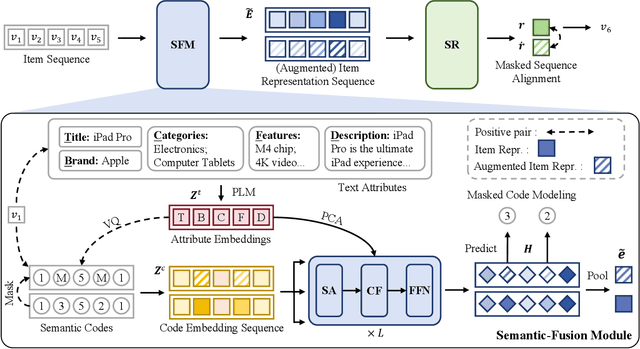



Abstract:In recent years, substantial research efforts have been devoted to enhancing sequential recommender systems by integrating abundant side information with ID-based collaborative information. This study specifically focuses on leveraging the textual metadata (e.g., titles and brands) associated with items. While existing methods have achieved notable success by combining text and ID representations, they often struggle to strike a balance between textual information embedded in text representations and collaborative information from sequential patterns of user behavior. In light of this, we propose CoCoRec, a novel Code-based textual and Collaborative semantic fusion method for sequential Recommendation. The key idea behind our approach is to bridge the gap between textual and collaborative information using semantic codes. Specifically, we generate fine-grained semantic codes from multi-view text embeddings through vector quantization techniques. Subsequently, we develop a code-guided semantic-fusion module based on the cross-attention mechanism to flexibly extract and integrate relevant information from text representations. In order to further enhance the fusion of textual and collaborative semantics, we introduce an optimization strategy that employs code masking with two specific objectives: masked code modeling and masked sequence alignment. The merit of these objectives lies in leveraging mask prediction tasks and augmented item representations to capture code correlations within individual items and enhance the sequence modeling of the recommendation backbone. Extensive experiments conducted on four public datasets demonstrate the superiority of CoCoRec, showing significant improvements over various sequential recommendation models. Our code is available at https://anonymous.4open.science/r/CoCoRec-6E41.
End-to-End Learnable Item Tokenization for Generative Recommendation
Sep 09, 2024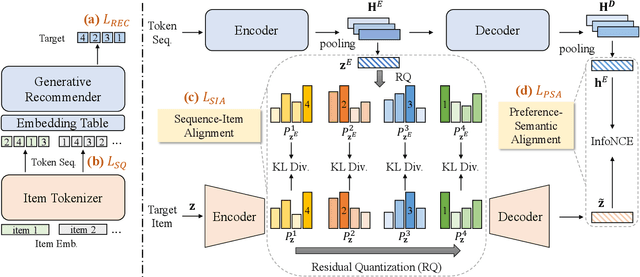
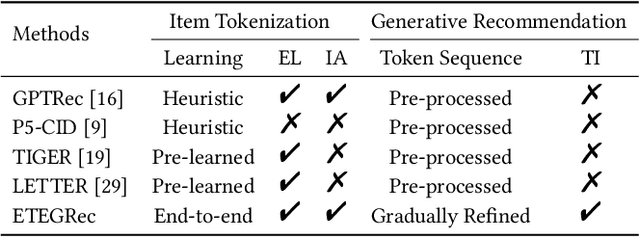

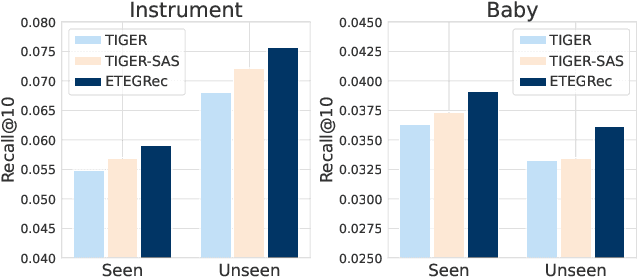
Abstract:Recently, generative recommendation has emerged as a promising new paradigm that directly generates item identifiers for recommendation. However, a key challenge lies in how to effectively construct item identifiers that are suitable for recommender systems. Existing methods typically decouple item tokenization from subsequent generative recommendation training, likely resulting in suboptimal performance. To address this limitation, we propose ETEGRec, a novel End-To-End Generative Recommender by seamlessly integrating item tokenization and generative recommendation. Our framework is developed based on the dual encoder-decoder architecture, which consists of an item tokenizer and a generative recommender. In order to achieve mutual enhancement between the two components, we propose a recommendation-oriented alignment approach by devising two specific optimization objectives: sequence-item alignment and preference-semantic alignment. These two alignment objectives can effectively couple the learning of item tokenizer and generative recommender, thereby fostering the mutual enhancement between the two components. Finally, we further devise an alternating optimization method, to facilitate stable and effective end-to-end learning of the entire framework. Extensive experiments demonstrate the effectiveness of our proposed framework compared to a series of traditional sequential recommendation models and generative recommendation baselines.
A Large Language Model Enhanced Sequential Recommender for Joint Video and Comment Recommendation
Mar 20, 2024


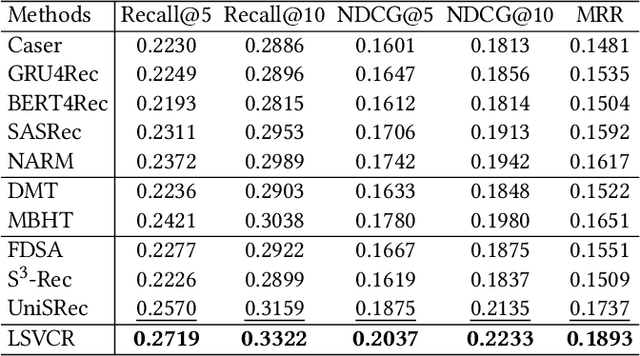
Abstract:In online video platforms, reading or writing comments on interesting videos has become an essential part of the video watching experience. However, existing video recommender systems mainly model users' interaction behaviors with videos, lacking consideration of comments in user behavior modeling. In this paper, we propose a novel recommendation approach called LSVCR by leveraging user interaction histories with both videos and comments, so as to jointly conduct personalized video and comment recommendation. Specifically, our approach consists of two key components, namely sequential recommendation (SR) model and supplemental large language model (LLM) recommender. The SR model serves as the primary recommendation backbone (retained in deployment) of our approach, allowing for efficient user preference modeling. Meanwhile, we leverage the LLM recommender as a supplemental component (discarded in deployment) to better capture underlying user preferences from heterogeneous interaction behaviors. In order to integrate the merits of the SR model and the supplemental LLM recommender, we design a twostage training paradigm. The first stage is personalized preference alignment, which aims to align the preference representations from both components, thereby enhancing the semantics of the SR model. The second stage is recommendation-oriented fine-tuning, in which the alignment-enhanced SR model is fine-tuned according to specific objectives. Extensive experiments in both video and comment recommendation tasks demonstrate the effectiveness of LSVCR. Additionally, online A/B testing on the KuaiShou platform verifies the actual benefits brought by our approach. In particular, we achieve a significant overall gain of 4.13% in comment watch time.
A deep reinforcement learning approach for real-time demand-responsive railway rescheduling to mitigate station overcrowding using mobile data
Aug 23, 2023Abstract:Real-time railway rescheduling is a timely and flexible technique to automatically alter the operation schedule in response to time-varying conditions. Current research lacks data-driven approaches that capture real-time passenger mobility during railway disruptions, relying mostly on OD-based data and model-based methods for estimating demands of trains. Meanwhile, the schedule-updating principles for a long-term disruption overlook the uneven distribution of demand over time. To fill this gap, this paper proposes a demand-responsive approach by inferring real-world passenger mobility from mobile data (MD) to facilitate real-time rescheduling. Unlike network-level approaches, this paper focuses on a heavy-demand station upstream of the disrupted area. The objective is to reschedule all trains on multiple routes passing through this target station, which have been affected by a severe emergency event such as a natural disaster. Particular attention should be given to avoiding the accumulation of overcrowded passengers at this station, to prevent additional accidents arising from overcrowding. This research addresses the challenges associated with this scenario, including the dynamics of arriving and leaving of passengers, station overcrowding, rolling stock shortage, open-ended disruption duration, integrated rescheduling on multiple routes, and delays due to detours. A deep reinforcement learning (DRL) framework is proposed to determine the optimal rescheduled timetable, route stops, and rolling stock allocation, while considering real-time demand satisfaction, station overcrowding, train capacity utilization, and headway safety.
 Add to Chrome
Add to Chrome Add to Firefox
Add to Firefox Add to Edge
Add to Edge